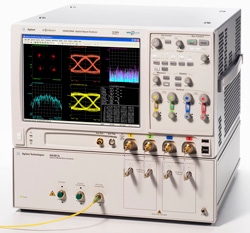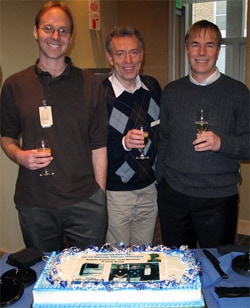|
Prize Honors Industry-First Solution for Optical Measurement
January 28, 2011
Agilent Research Laboratories presented the 2010 Barney Oliver Prize for Innovation to Bogdan Szafraniec, Todd Marshall and Doug Baney in the Measurement Research Laboratory's Measurement and Sensors Department. They contributed to the measurement of optical communication signals using complex modulation formats and to the rapid commercialization of this capability. The Agilent N4391A, the industry's first time-domain based optical modulation analyzer, enables optics researchers to use amplitude, phase and polarization properties of light, thus increasing the efficiency of the fiber-optic pipes that transport Internet traffic.
 Bill Sullivan, Todd Marshall, Doug Baney, Bogdan Szafraniec, Darlene Solomon The Barney Oliver Prize recognizes outstanding technical contributions at Agilent Research Laboratories that demonstrate creativity, innovation, technical depth, synergy and business value. Bogdan and Doug also received this prize in 2003 for their contributions to optical spectrum analysis and component analysis.
"The work of Bogdan, Todd and Doug stands out as very deserving of this special recognition," said Agilent Chief Technology Officer Darlene Solomon. "The Agilent N4391A optical modulation analyzer is a great example of technology innovation. In close partnership with the Digital Photonic Test business, the team successfully anticipated future customer needs that enabled Agilent to deliver the right new product at the right time. The Research Labs team innovated key breakthroughs
and at the same time leveraged core existing hardware, software and algorithms across Agilent's electronic measurement portfolio."
"Agilent Research Labs are a key part of our continued investment in new measurement technologies across the spectrum of electronics, life sciences and chemical analysis," said Agilent CEO Bill Sullivan. "But what really differentiates Agilent is the quality of our people - their ability to innovate, commercialize new ideas and drive value for our customers.
"Agilent's goal is to be the technology leader in every one of our core platforms, and the N4391A optical modulation analyzer is a great example of that leadership. I am pleased to recognize this year's winners of the Barney Oliver Prize for Innovation."
Optical Communication Challenges
In the early 2000s, the bubble in optical communication burst, resulting in a crash and reduced investment in optical communications. From about 2001 to 2006, when Internet companies needed to respond to bandwidth demand, they used the equipment they had to transmit more colors simultaneously over a single optical fiber. This digital transmission was very simple: zeros and ones were sent by turning light "on" and "off." Old-fashioned telegraphs used this type of transmission, called "on-off" keying.
But as the world's appetite for bandwidth continued to increase, Internet transmission required something more sophisticated than on-off keying. Optical researchers and telecommunication companies began emulating the more complex-modulation formats used in wireless communications to allow them to stuff more bits onto each color. In addition to "on" and "off," the amplitude, phase and polarization of the optical field can be used to carry more information. This new complex modulation format allowed more bits to be transmitted on each color; however, it presented a measurement challenge: it's extremely difficult to characterize these complex signals on fields wiggling 200,000 billion times per second. [1, 4]
Because no instrument was available to measure such complex optical signals, many companies tried to develop their own home-built instruments. These solutions could cost $300,000 or more just for the hardware, and probably many times as much for engineering time to develop such a system.
As interest in complex optical signal modulation grew, Bogdan, Todd, Doug and the team in Agilent's Digital Photonic Test (DPT) business monitored these technology trends so Agilent could be ready to offer test solutions for advanced modulation format transmission at the right time.
Demonstration at the Optical Fiber Communication Conference
With a decision made to launch a project to provide customers a solution to their complex signal test needs, the team moved forward aggressively. The goal was to show the measurement solution at the Optical Fiber Conference (OFC) in March 2009. The two R&D teams launched a fast-track project that brought together DPT's fiber optic instrumentation capability, Agilent's superfast oscilloscopes and novel optical signal measurement science from MRL's coherent optical research.
"We monitored this space well in advance to get the timing right, so that when we staffed an investigation, the resulting product would be delivered rapidly into the emerging complex signal test market," said Doug. "To speed our research, we chose a highly collaborative model working very closely with DPT engineers, as opposed to a classical sequential transfer of technology. The breadth of Agilent's capability, and the passion and creativity of the joint team were critical to the project's success."
The Agilent N4391A Optical Modulation Analyzer
The team met the goal of a demonstration at OFC 2009. The prototype demonstrated simultaneous measurements of amplitude and phase of two polarization channels and attracted the attention of optical communication researchers. The Agilent N4391A optical modulation analyzer (OMA) was released to shipment later that year.
 Agilent N4391A optical modulation analyzer The OMA enables in-depth calibrated analysis of complex optical signals and gives deep insight into transceiver designs and the quality of the components. It allows customers to focus on their transceiver business instead of deflecting limited resources into investigating and building their own proprietary test solutions.
The OMA leverages four important Agilent technologies: tunable lasers, advanced photonics measurement science, wide-bandwidth oscilloscopes, and Vector Analysis Software used in microwave spectrum analyzers for wireless communications.
The OMA won the Test & Measurement World 2010 Best in Test Award in the Fiber Optics Category. Some customers found it hard to believe that it was possible to obtain the flawless polarization state tracking that the N4391A had achieved through fundamental advances in photonic measurement science [2, 3].
 Winners Todd, Bogdan and Doug In addition to revenue, the OMA provides strategic benefits. It serves as an example of Agilent's ability to combine its technology breadth to create something entirely new that provides compelling customer value. As a fundamental and unique research tool for cutting-edge telecommunications research, the OMA strengthens Agilent's position as a leader in coherent optical communication. It also encourages customer preference for Agilent equipment in this and related spaces.
"This is a classic example of speed to opportunity by a world class team," said Steve Newton vice president Technology, and director, Measurement Research Laboratory. "As leaders in the photonics field, the team quickly realized that optical signals would soon be transmitted using the same modulation schemes commonly used in wireless, another area of leadership for Agilent. They recognized that by combining existing Agilent capabilities in modulation analysis and signal acquisition with their own innovations in optical measurement science, we could quickly attain a leadership position in a new measurement domain. They achieved that goal quickly through innovation and teamwork."
Additional Praise
"The N4391A optical modulation analyzer is the workhorse instrument for scientists, development engineers, and quality engineers of transmission system and component suppliers, thus supporting the development of next-generation high-speed optical networks." Juergen Beck, General Manager, Digital Photonic Test Business
"I congratulate Doug Baney, Bogdan Szafraniec and Todd Marshall for winning the Barney Oliver Prize for Innovation. Work on the N4391A optical modulation analyzer is a role model for effective teamwork of Agilent Research Laboratories and product generating organizations. The demonstrated Agilent values of speed to opportunity and R&D effectiveness, along with innovation power and Agilent's leading technology, are fundamental for our future business success and outstanding product competitiveness. With the N4391A we have been able to significantly strengthen our position as a provider of high speed digital test solutions to component manufacturers, network equipment manufacturers and network operators." Emmerich Mueller, R&D Manager Digital Photonic Test Business
"By maintaining focus and solving key technical issues, Bogdan, Todd and Doug were able to follow through together with the divisions' R&D department on their vision to demonstrate an optical modulation analyzer at the Optical Fiber Conference in 2009. The product started shipping a few months later. Many customers have commented that the N4391A optical modulation analyzer is the right product at the right time. The R&D velocity was great, and the product put Agilent in a technical leadership position in a brand-new market segment in optical communication. This segment has tremendous market potential in the coming decade." Oliver Funke, Agilent Product Manager N4391A
"Our collaboration with the MRL team was great. Bogdan, Todd and Doug solved the problems differently than what is found in the literature. Our team's and Agilent's boldness to deviate from the well known paths is exactly what gives us a competitive advantage." Bernd Nebendahl, Digital Photonic Test business N4391A Project Manager
"The N4391A was one of the projects that I loved. It had high scientific content and allowed us to work in the frontiers of the metrology of optical signals and systems." Bogdan Szafraniec, MRL Researcher and Barney Oliver Prize Winner "This is exactly the kind of test instrument that fills the gap for the optical industry, as engineers can now gain deep insight into the behavior of transmitters and links operating with advanced optical modulation schemes," Niall Robinson, vice president of product marketing, Mintera Corp. Agilent Technologies to Unveil Industry-First Optical Modulation Analyzer for 40/100G Physical Layer Test at OFC/NFOEC 2009
References
1. B. Nebendahl and B. Szafraniec. "Metrology of Advanced Optical Modulation Formats," Agilent Technologies, Inc., 5990-3748EN, (2009).
2. Bogdan Szafraniec, Bernd Nebendahl, and Todd Marshall, "Polarization Demultiplexing in Stokes Space," Opt. Express 18 (17) Aug. 16, 2010: 17928-17939.
3. Todd Marshall, Bogdan Szafraniec, and Bernd Nebendahl, "Kalman Filter Carrier and Polarization-state Tracking." Opt. Lett. 35 (13) July 1, 2010: 2203-2205.
4. B. Szafraniec, T. Marshall, and B. Nebendahl. "Kalman Filter Based Estimation and Demodulation of Complex Signals," Agilent Technologies, Inc., 5990-6409EN, (2010).
|